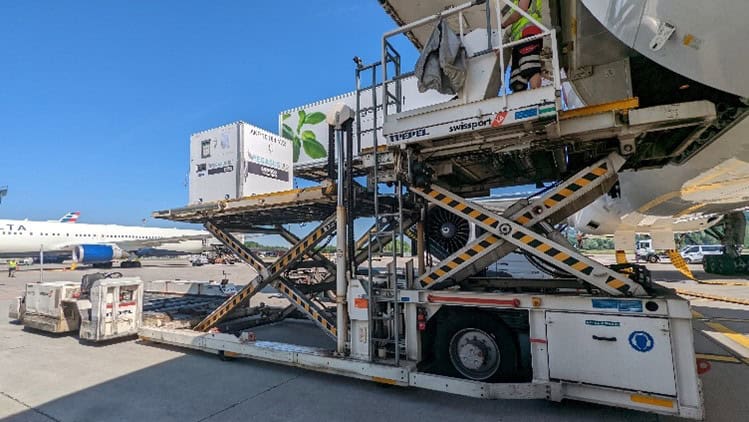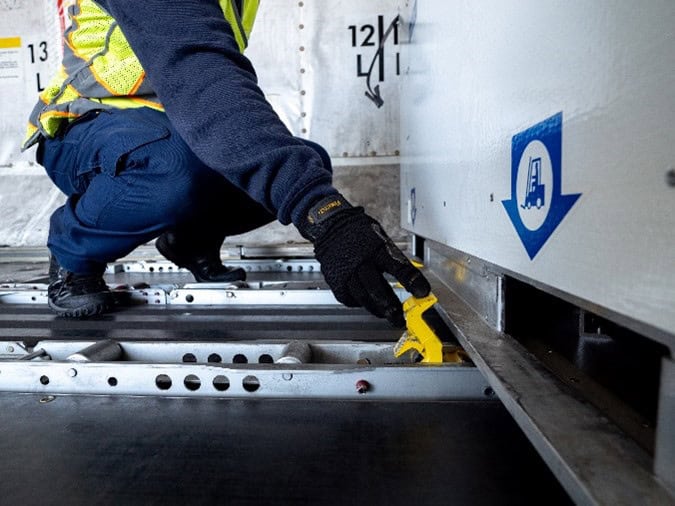MAY 28, 2024
Air Freight Building Blocks: Partnerships, Quality Control, Technology & Sustainability

During the recent LogiPharma conference in Lyon, France, Sonoco ThermoSafe hosted a Masterclass session with pharmaceutical, biotech and logistics partners. The educational session focused on the necessary components of an effective and compliant air freight supply chain. The panel of experts included several of the key stakeholders.
Moderator:
Bourji Mourad, Director, Global Leasing & Market Development, Sonoco ThermoSafe – Pegasus ULD
Panelists:
Susanne Wellauer, Industry Manager, Pharma & Healthcare, Swiss WorldCargo
Andreas Behnke, CEO & Station Manager Basel, Swissport
Chris Wallace, Head of Distribution EMEA, Argenx
As the pharmaceutical industry increasingly relies on temperature-sensitive shipments, ensuring seamless logistics control and monitoring becomes a critical concern.
- How can companies guarantee that every link in the supply chain is robust, with detailed contingency plans for every scenario?
- With the rise of cold chain medicines, what are the implications of adopting different packaging technologies, and how can the qualification process be streamlined to keep pace with innovation?
- Furthermore, as pharmaceutical companies negotiate direct leasing agreements with packaging partners, what are the potential impacts on pricing and supply chain dynamics?
This discussion delves into these pressing questions, highlighting the complexities and urgent need for meticulous planning and collaboration in pharmaceutical logistics, including these 3 core areas:
- Critical collaboration points to ensure 100% logistics control and monitoring at all times
The panel discussion, moderated by Bourji Mourad, dove into the need for precise collaboration for temperature-sensitive pharmaceutical shipments. Bourji highlighted the importance of robust, fully documented Standard Operating Procedures (SOPs) that include detailed contingencies for various trade lanes and scenarios, including out-of-office hours and differing weekend schedules globally.
Chris Wallace, Head of Distribution EMEA at Argenx, emphasized the necessity of having detailed processes involving every partner and stakeholder in the supply chain. He noted that despite thorough planning, mistakes can occur, especially when downstream staff could be unaware or untrained. Proactive measures and constant vigilance are crucial to mitigating risks. In response to a question about handling temperature alerts during shipment, Chris underscored the importance of having a clear SOP and knowing exactly who to contact when deviations are detected to promptly address any issues.

Susanne Wellauer and Andreas Behnke shared their perspectives from the airline and ground handling viewpoints, respectively. Susanne discussed the challenges faced when supply chain partners, such as forwarders or pharmaceutical companies, do not provide SOPs. She stressed the need for airlines to have their own stringent protocols to manage such situations. Andreas elaborated on the potential issues that can arise with temperature-sensitive shipments at airports, whether using passive or active packaging solutions. He pointed out that ground handling requires meticulous coordination to prevent temperature excursions and ensure the integrity of the pharmaceutical products throughout their journey.
- Learning how to work with supply chain partners to use the different types of packaging and technologies, ie: Passive, Active, Reusable, Single Use etc.
The panel then shifted direction to utilizing different types of packaging and technologies for pharmaceutical shipments. Bourji emphasized the necessity of contingency plans, noting that companies often use various packaging solutions, such as passive, active, reusable, and single use, to meet different temperature and shipping requirements. He highlighted the importance of having backup plans and pre-qualified packaging to ensure seamless operations.
Chris Wallace discussed the factors influencing the choice between secondary and primary packaging solutions. He identified cost and sustainability as key drivers in these decisions. Chris noted that the decision-making process involves evaluating the specific needs of the product, including temperature sensitivity, and balancing these requirements with economic and environmental considerations.

Susanne Wellauer and Andreas Behnke addressed the operational adaptations needed for new packaging types in airfreight services. Susanne explained that airlines must be flexible and ready to adjust their processes when customers introduce new packaging solutions. She also touched on the challenges of handling temperature-sensitive shipments at locations not equipped for such operations, emphasizing the need for timely setup and process changes. Andreas elaborated on the handling of pharmaceutical shipments at airports, noting that different packaging types require specific protocols to maintain product integrity throughout the shipping process.
But wait, we must qualify
The discussion then focused on the challenges and strategies for implementing new packaging into compliant operations, specifically the qualification process. Chris Wallace addressed the difficulties of qualifying new packaging solutions, noting that it can be a significant hurdle. The group agreed that using software-based risk analysis could expedite the qualification process, making it more efficient and less time-consuming.

Bourji also highlighted the trend of pharmaceutical companies seeking simplicity in operations, including packaging, as the number of cold chain medicines increases. This trend includes negotiating direct leasing agreements with packaging partners for bulk packaging. Chris acknowledged the benefits of such direct negotiations, stating that they could streamline operations and potentially reduce costs. However, he also noted that these agreements could impact pricing and the overall supply chain, requiring careful consideration and strategic planning to ensure they align with the company’s operational needs and financial goals.
- Adapting to sustainable passive air freight Temperature Control Containers (TCC)
Sustainability comes in various shapes and sizes – not just one. In air freight, the selection of which type of TCC is used weighs heavily into the sustainability calculation.
For example:
Single-Use vs. Reusable = the goal is less waste, right?
What about Active vs. Passive? = do we know the sustainability comparisons?
ULD – can be reused, reloaded and repositioned = sustainability outcomes?
ULD – significant differences in airport operations = higher sustainability
As companies and partners get to grips with sustainability initiatives, there are many variables to consider and many ways to evaluate the data. The Sonoco ThermoSafe team is using Life Cycle Analysis (LCA) assessments to evaluate and compare different types of packaging for customer specific applications, including air freight. A recent webinar “Sustainability Tradeoffs for Thermal Packaging” explained in detail how there isn’t always just one right choice when balancing the need for performance in the packaging, with sustainability goals. Access the on-demand webinar here.
Interested in learning more about sustainable air freight? Explore how the Pegasus ULD rental program offers a sustainable passive solution and learn about the airline partner network, visit https://www.thermosafe.com/products/pre-qualified-solutions/rental-solutions/pegasus-uld/
What’s next?
In conclusion, the panel discussion underscored the critical importance of careful collaboration and robust planning in the logistics of temperature-sensitive pharmaceutical shipments. The conversation revealed the complexities of maintaining control and monitoring across the supply chain, the necessity of having well-documented SOPs, and the challenges of adapting to new packaging technologies. As the industry evolves, the need for streamlined qualification processes and strategic partnerships becomes increasingly evident. Addressing these concerns is essential for maintaining the integrity of pharmaceutical products, optimizing operations, and navigating the ever-changing landscape of pharmaceutical logistics.

